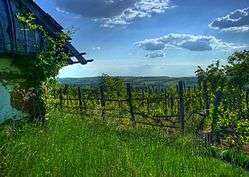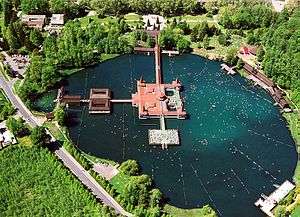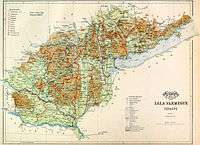Zala County
| Zala County | |||
|---|---|---|---|
   | |||
| |||
 | |||
| Country | Hungary | ||
| Region | Western Transdanubia | ||
| County seat | Zalaegerszeg | ||
| Government | |||
| • President of the General Assembly | Dr. Attila Pál (Fidesz-KDNP) | ||
| Area | |||
| • Total | 3,783.89 km2 (1,460.97 sq mi) | ||
| Area rank | 14th in Hungary | ||
| Population (2011 census) | |||
| • Total | 282,179 | ||
| • Rank | 16th in Hungary | ||
| • Density | 75/km2 (190/sq mi) | ||
| Postal code | 8353 – 839x, 874x – 879x, 880x – 883x, 8855, 8856, 886x – 889x, 89xx | ||
| Area code(s) | (+36) 83, 92, 93 | ||
| ISO 3166 code | HU-ZA | ||
| Website |
www | ||
Zala (Slovene: Zalska županija or županija Zala) is an administrative county (comitatus or megye) in south-western Hungary. It is named after the Zala River. It shares borders with Croatia and Slovenia and the Hungarian counties Vas, Veszprém and Somogy. The capital of Zala county is Zalaegerszeg. Its area is 3,784 square kilometres (1,461 sq mi). Lake Balaton lies partly in the county.
History

In the 10th century, the Hungarian Nyék tribe occupied the region around Lake Balaton. Their occupation was mainly in the areas known today as Zala and Somogy counties.[1]
Parts of the western territory of the former county of Zala are now part of Slovenia (South-Prekmurje). In 1919 it was part of the unrecognized state of the Republic of Prekmurje, which existed for just six days.
Demographics
In 2015, it had a population of 277,290 and the population density was 73/km².
| Year | County population[2] | Change |
|---|---|---|
| 1949 | 305,433 | n/a |
| 1960 | 3.83% | |
| 1970 | -4.10% | |
| 1980 | 4.33% | |
| 1990 | -3.44% | |
| 2001 | -2.94% | |
| 2011 | -5.12% |
Ethnicity
Besides the Hungarian majority, the main minorities are the Roma (approx. 7,000), Croats (3,500) and Germans (2,000).
Total population (2011 census): 282,179
Ethnic groups (2011 census):[3]
Identified themselves: 255 069 persons:
- Hungarians: 241 408 (94,64%)
- Gypsies: 6 981 (2,74%)
- Croats: 3 248 (1,27%)
- Others and indefinable: 3 432 (1,35%)
Approx. 38,000 persons in Zala County did not declare their ethnic group at the 2011 census.
Religion
Religious adherence in the county according to 2011 census:[4]
- Catholic – 62.8% (Roman Catholic – 62.6%; Greek Catholic – 0.1%);
- Reformed – 2.5%;
- Evangelical – 1.4%;
- other religions – 0.8%;
- Non-religious – 8.2%;
- Atheism – 0.8%;
- Undeclared – 23.5%.
Politics
The Zala County Council, elected at the 2014 local government elections, is made up of 15 counselors, with the following party composition:[5]
| Party | Seats | Current County Assembly | |||||||||
|---|---|---|---|---|---|---|---|---|---|---|---|
| Fidesz-KDNP | 9 | ||||||||||
| Movement for a Better Hungary (Jobbik) | 4 | ||||||||||
| Hungarian Socialist Party (MSZP) | 1 | ||||||||||
| Democratic Coalition (DK) | 1 | ||||||||||
Municipalities
Cities with county rights
- Zalaegerszeg (county seat)
- Nagykanizsa
Cities and towns
(ordered by population, according to the 2001 census)
- Keszthely (21,944)
- Lenti (8,559)
- Zalaszentgrót (7,944)
- Letenye (4,613) from above
- Hévíz (4,523)
- Zalalövő (3,256)
- Pacsa (1,904)
- Zalakaros (1,519)
Villages
Gallery
_5.jpg) Zalaegerszeg, the capital of the county
Zalaegerszeg, the capital of the county_24.jpg)
 Hévíz, the largest thermal lake in Europe
Hévíz, the largest thermal lake in Europe- Batthyány Palace in Zalaszentgrót
- Traditional Hungarian house in Zalalövő
References
- ↑ Béla Kálmán, The world of names: a study in Hungarian onomatology, Akadémiai Kiadó, 1978, p. 134
- ↑ népesség.com, "Győr-Moson-Sopron megye népessége 1870-2015"
- ↑ 1.1.6. A népesség anyanyelv, nemzetiség és nemek szerint – Frissítve: 2013.04.17.; Hungarian Central Statistical Office (Hungarian)
- ↑ 2011. ÉVI NÉPSZÁMLÁLÁS, 3. Területi adatok, 3.20 Zala megye, (Hungarian)
- ↑ Zala Megyei Közgyűlés, (Hungarian)
External links
| Wikimedia Commons has media related to Zala County. |
- Official site in Hungarian and German
- Zalai Hírlap (zaol.hu) - The county portal
Coordinates: 46°40′N 16°50′E / 46.667°N 16.833°E

.svg.png)